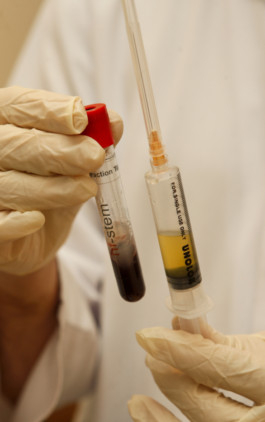
A syringe full of sugar is the revolutionary treatment offered in the UAE to bring relief to people suffering for years from chronic pain of the muscles and joints.
This new concept in the field of medical science looks into the regeneration of the tissues rather than just treating the symptoms, according to a doctor who is the only one in the Middle East offering this treatment.
The treatment is called Prolotherapy (Prolo is abbreviation of Proliferation) and essentially consists of a syringe full of dextrose injected into the area of pain. This leads to a stimulation of the tissues to heal themselves, thus providing relief from a range of chronic pain conditions, says
Dr Suad Trebinjac, head of physical medicine and rehabilitation department, Rashid Hospital, the emirate’s leading government hospital, of pain and musculoskeletal disorders, which affect the body’s muscles, tendons, ligaments, cartilages and nerves, “There are plenty of medications for pain - physiotherapy, alternative therapies such as ayurveda or accupuncture, but all these offer symptomatic treatments. Soon, the pain returns and the patient has to visit doctors frequently. This history of pain makes him frequently absent from his work and he also has other social issues.”
The lateral connection between pain and pain killers, says Dr Trebinjac, does not obviate the adverse side-effects. “Chronic pain usually means that because you are suffering from pain for years, you end up taking pain killers for years as well. The medications could damage your stomach, kidney or liver”, as these medicines have to travel through the body causing harm on the way.
On the other hand, the new form of treatment, prolotherapy, works differently. “Prolotherapy injections,” says the doctor, “go directly to the point of the problem and as such are harmless.”
However, there are some caveats. “Till recently, there was no scientific evidence that prolotherapy worked,” says Dr Trebinjac. “The pioneers in this field were clinicians and did not keep documented proof.”
However, “Recent evidence has confirmed that this treatment is more efficient that anything that has been tried so far. By efficient, it means that the relief it offers is for much longer. This was corroborated by two studies in the US and one in India, conforming significant pain reduction in patients with knee osteoarthritis lasting for more than one year,” says the doctor.
Just last week, another study showed that dextrose injection treatment worked and the patient with knee problem showed significant improvement. There was reduction in pain as well as functional improvement as the patient could walk for a longer distance.”
The theory behind this treatment, Dr Trebinjac explains, is that the injections trigger small inflamatory reactions which stimulates the natural process of tissue repair and healing.
In the early years of the prolotherpy, three natural substances were injected into the affected areas - dextrose or glucose, sodium morrhuate, a derivative of cod liver oil extract, and a mixture of phenol, glycerin and glucose called P2G.
Today, instead of P2G, Platelet Rich Plasma (PRP) treatment is gaining more and more popularity. It is another form of Prolotherapy where blood is taken from the patient’s vein, spun in a centrifuge machine to get a high concentrated vial of platelets from the plasma. This is injected into the patient’s pain areas of the damaged structure, whether the ligament, tendon or joint, to stimulate the healing process.
Top American athletes have undergone this treatment which has proved successful. There are growth factors in the platelets that encourage the recovery of the tissue.
In the young, pain management is lifestyle related, says Dr Trebnijac. “Sports injuries are common among the young,” he explains. On the other hand, “In older people, pain can be due to the degeneration of the tissues as part of the ageing process. The cartilages get thinner and the tendons are exposed to many micro trauma. You can go for years without symptoms but by middle age, it starts to hurt.”
Dr Trebnijac explains the difference between muscular pain and tendon and ligament pain. “The muscles in our body are red in colour because of very good vascularisation and there is good blood supply. Tendons and ligaments, on the other hand, are white in colour as the blood supply to them is not that good. When they sustain an injury, the healing process takes time and there is chronic pain. Basbetball and football players live with this kind of a pain for years.”
Prolotherapy, he believes, is an exciting new breakthrough in medicine because, “We encourage our own body to heal itself and the damaged structures.” Many tendon injuries, for example, become chronic, he says, because of a very minute tearing of the tendon or muscle, which cannot be corrected by surgery. But with the help of prolotherapy, the concentrated platelets are coaxed into boosting the nutrients and growth factors that allow the body to heal itself.
Dr Trebnijac is the first specialist to apply the dextrose prolotherapy in the region is now practising Platelet Ric Plasma (PRP) treatment at Al Garhoud Private Hospital and also plans to bring in stem cells therapy, where stem cells are injected into the site of the damage. “The stem cells regenerate the cells that are damaged,” he says, but adds that he is waiting for more evidence.
“We are the following the research being done in this field. It will be an expensive project to bring here but we are not in a hurry to be the first.“
However, prolotherapy is not for everyone. “It’s not a miracle treatment.” Patients with acute inflammation and systemic disorders are not good candidates for prolotherapy, he adds. “They do not respond properly to the treatment. Only patients with chronic pain are chosen. We get the MRI (Magnetic Resonance Imaging) or an ultra-sound done to find out the condition and the source of pain and only then start the treatment,” he says.
There is a proper method of selecting the patient who will benefit from prolotherapy. If they follow the whole course of treatment, says Dr Trebnijac, many get relief and a very good number of patients do not come back again for further treatment.
Even then, before beginning the treatment, patients are advised to try something else first such as physiotherapy, etc. If nothing works, prolotherapy is offered. “I have been following patients for more than three years, and it is very rare that they don’t respond to the treatment. They are either free of pain or it much less than before,” he says.
“The important fact is that Dextrose Prolo and PRP are very safe procedures without significant side effects. This new therapy is very popular in the States and is now capturing the world’s attention. In the UAE though, people are yet unaware that such a treatment exists,” Dr Trebinjac.












